Literature Review: Therapeutic Communication for Aggressive Patients
VerifiedAdded on 2023/06/05
|10
|2240
|79
Literature Review
AI Summary
This paper provides a literature review of nursing communication interventions for managing aggressive patients in the emergency department (ED). It addresses the high prevalence of violence and aggression in the ED and examines the effectiveness of therapeutic communication skills, including de-escalation strategies and training programs, in managing aggressive behavior. The review highlights the potential of communication training to reduce violence episodes and emphasizes the need for further studies to validate these findings. The study uses a qualitative approach, including a PICO framework, to analyze existing research and identify key strategies for managing aggressive patients in the ED. Desklib offers a platform to explore more solved assignments and study resources related to this topic.
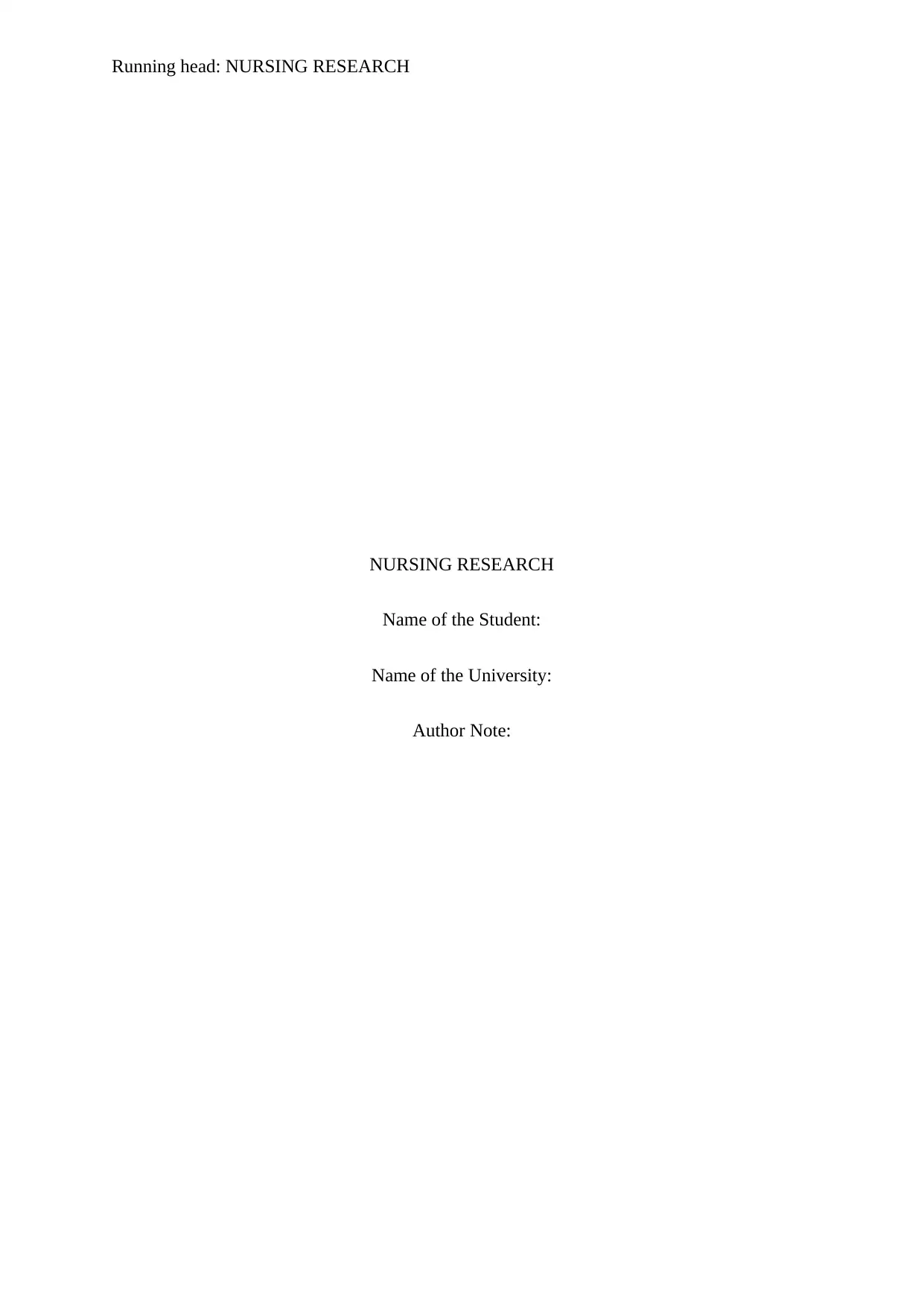
Running head: NURSING RESEARCH
NURSING RESEARCH
Name of the Student:
Name of the University:
Author Note:
NURSING RESEARCH
Name of the Student:
Name of the University:
Author Note:
Paraphrase This Document
Need a fresh take? Get an instant paraphrase of this document with our AI Paraphraser
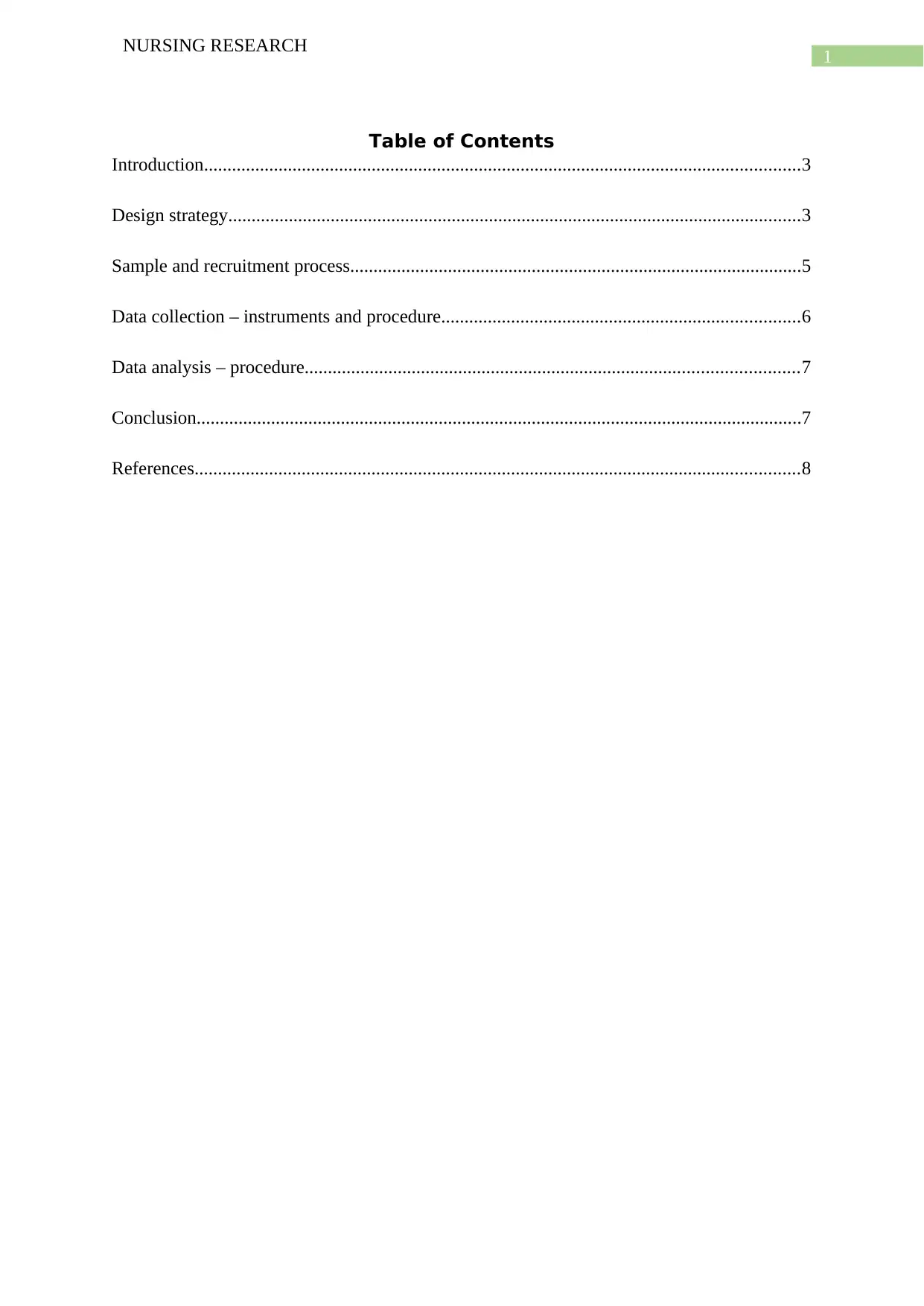
1
NURSING RESEARCH
Table of Contents
Introduction................................................................................................................................3
Design strategy...........................................................................................................................3
Sample and recruitment process.................................................................................................5
Data collection – instruments and procedure.............................................................................6
Data analysis – procedure..........................................................................................................7
Conclusion..................................................................................................................................7
References..................................................................................................................................8
NURSING RESEARCH
Table of Contents
Introduction................................................................................................................................3
Design strategy...........................................................................................................................3
Sample and recruitment process.................................................................................................5
Data collection – instruments and procedure.............................................................................6
Data analysis – procedure..........................................................................................................7
Conclusion..................................................................................................................................7
References..................................................................................................................................8
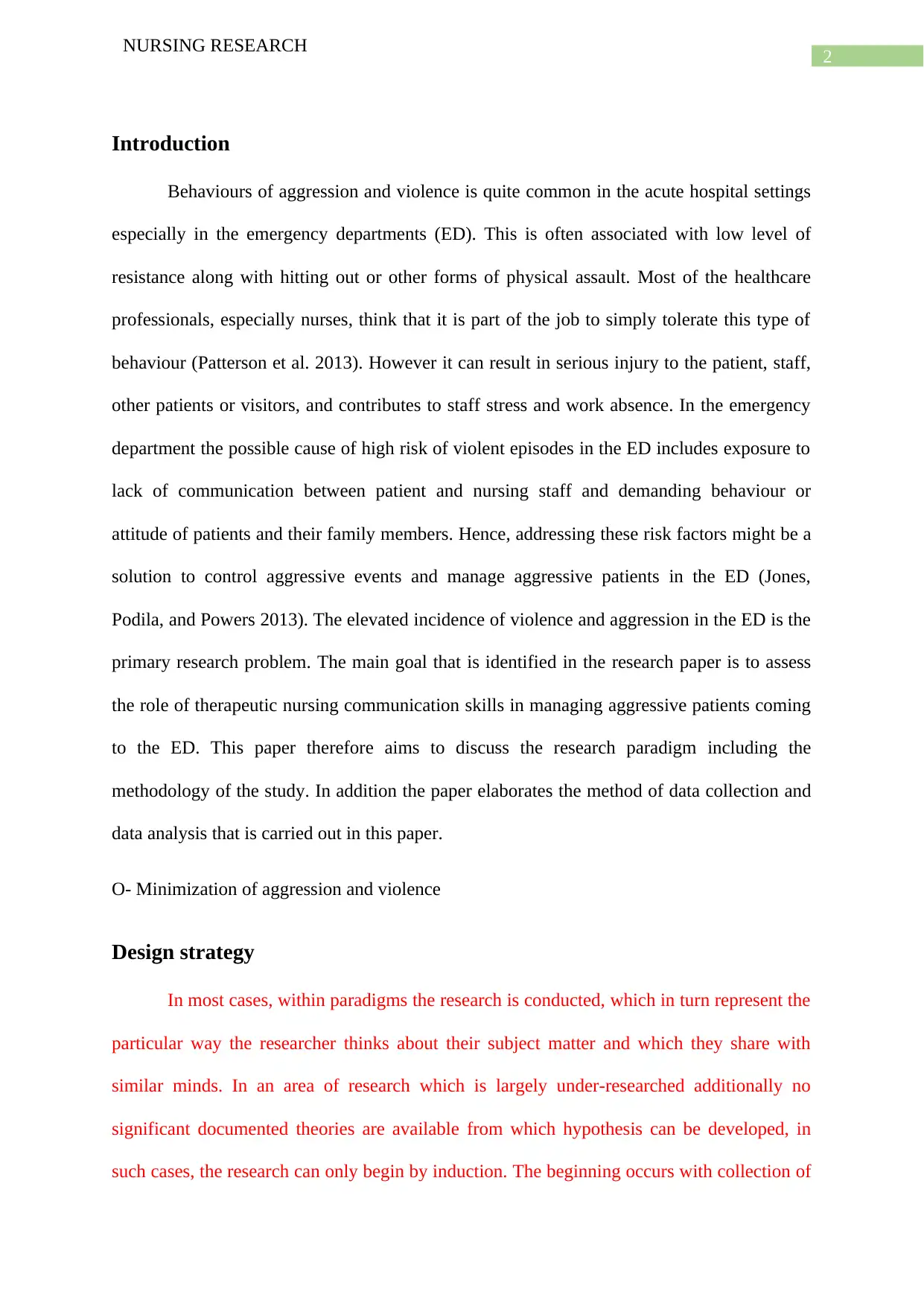
2
NURSING RESEARCH
Introduction
Behaviours of aggression and violence is quite common in the acute hospital settings
especially in the emergency departments (ED). This is often associated with low level of
resistance along with hitting out or other forms of physical assault. Most of the healthcare
professionals, especially nurses, think that it is part of the job to simply tolerate this type of
behaviour (Patterson et al. 2013). However it can result in serious injury to the patient, staff,
other patients or visitors, and contributes to staff stress and work absence. In the emergency
department the possible cause of high risk of violent episodes in the ED includes exposure to
lack of communication between patient and nursing staff and demanding behaviour or
attitude of patients and their family members. Hence, addressing these risk factors might be a
solution to control aggressive events and manage aggressive patients in the ED (Jones,
Podila, and Powers 2013). The elevated incidence of violence and aggression in the ED is the
primary research problem. The main goal that is identified in the research paper is to assess
the role of therapeutic nursing communication skills in managing aggressive patients coming
to the ED. This paper therefore aims to discuss the research paradigm including the
methodology of the study. In addition the paper elaborates the method of data collection and
data analysis that is carried out in this paper.
O- Minimization of aggression and violence
Design strategy
In most cases, within paradigms the research is conducted, which in turn represent the
particular way the researcher thinks about their subject matter and which they share with
similar minds. In an area of research which is largely under-researched additionally no
significant documented theories are available from which hypothesis can be developed, in
such cases, the research can only begin by induction. The beginning occurs with collection of
NURSING RESEARCH
Introduction
Behaviours of aggression and violence is quite common in the acute hospital settings
especially in the emergency departments (ED). This is often associated with low level of
resistance along with hitting out or other forms of physical assault. Most of the healthcare
professionals, especially nurses, think that it is part of the job to simply tolerate this type of
behaviour (Patterson et al. 2013). However it can result in serious injury to the patient, staff,
other patients or visitors, and contributes to staff stress and work absence. In the emergency
department the possible cause of high risk of violent episodes in the ED includes exposure to
lack of communication between patient and nursing staff and demanding behaviour or
attitude of patients and their family members. Hence, addressing these risk factors might be a
solution to control aggressive events and manage aggressive patients in the ED (Jones,
Podila, and Powers 2013). The elevated incidence of violence and aggression in the ED is the
primary research problem. The main goal that is identified in the research paper is to assess
the role of therapeutic nursing communication skills in managing aggressive patients coming
to the ED. This paper therefore aims to discuss the research paradigm including the
methodology of the study. In addition the paper elaborates the method of data collection and
data analysis that is carried out in this paper.
O- Minimization of aggression and violence
Design strategy
In most cases, within paradigms the research is conducted, which in turn represent the
particular way the researcher thinks about their subject matter and which they share with
similar minds. In an area of research which is largely under-researched additionally no
significant documented theories are available from which hypothesis can be developed, in
such cases, the research can only begin by induction. The beginning occurs with collection of
⊘ This is a preview!⊘
Do you want full access?
Subscribe today to unlock all pages.

Trusted by 1+ million students worldwide
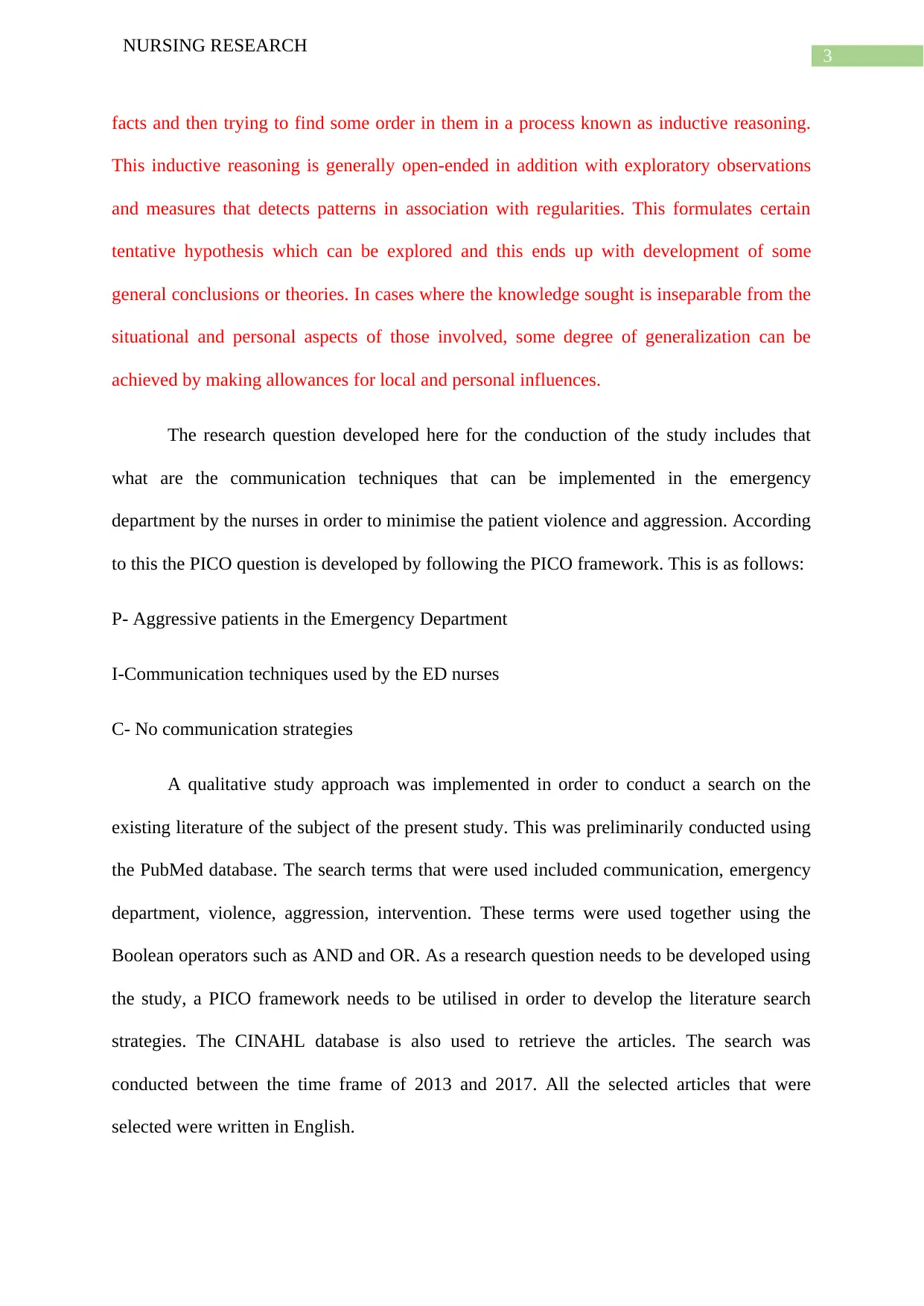
3
NURSING RESEARCH
facts and then trying to find some order in them in a process known as inductive reasoning.
This inductive reasoning is generally open-ended in addition with exploratory observations
and measures that detects patterns in association with regularities. This formulates certain
tentative hypothesis which can be explored and this ends up with development of some
general conclusions or theories. In cases where the knowledge sought is inseparable from the
situational and personal aspects of those involved, some degree of generalization can be
achieved by making allowances for local and personal influences.
The research question developed here for the conduction of the study includes that
what are the communication techniques that can be implemented in the emergency
department by the nurses in order to minimise the patient violence and aggression. According
to this the PICO question is developed by following the PICO framework. This is as follows:
P- Aggressive patients in the Emergency Department
I-Communication techniques used by the ED nurses
C- No communication strategies
A qualitative study approach was implemented in order to conduct a search on the
existing literature of the subject of the present study. This was preliminarily conducted using
the PubMed database. The search terms that were used included communication, emergency
department, violence, aggression, intervention. These terms were used together using the
Boolean operators such as AND and OR. As a research question needs to be developed using
the study, a PICO framework needs to be utilised in order to develop the literature search
strategies. The CINAHL database is also used to retrieve the articles. The search was
conducted between the time frame of 2013 and 2017. All the selected articles that were
selected were written in English.
NURSING RESEARCH
facts and then trying to find some order in them in a process known as inductive reasoning.
This inductive reasoning is generally open-ended in addition with exploratory observations
and measures that detects patterns in association with regularities. This formulates certain
tentative hypothesis which can be explored and this ends up with development of some
general conclusions or theories. In cases where the knowledge sought is inseparable from the
situational and personal aspects of those involved, some degree of generalization can be
achieved by making allowances for local and personal influences.
The research question developed here for the conduction of the study includes that
what are the communication techniques that can be implemented in the emergency
department by the nurses in order to minimise the patient violence and aggression. According
to this the PICO question is developed by following the PICO framework. This is as follows:
P- Aggressive patients in the Emergency Department
I-Communication techniques used by the ED nurses
C- No communication strategies
A qualitative study approach was implemented in order to conduct a search on the
existing literature of the subject of the present study. This was preliminarily conducted using
the PubMed database. The search terms that were used included communication, emergency
department, violence, aggression, intervention. These terms were used together using the
Boolean operators such as AND and OR. As a research question needs to be developed using
the study, a PICO framework needs to be utilised in order to develop the literature search
strategies. The CINAHL database is also used to retrieve the articles. The search was
conducted between the time frame of 2013 and 2017. All the selected articles that were
selected were written in English.
Paraphrase This Document
Need a fresh take? Get an instant paraphrase of this document with our AI Paraphraser
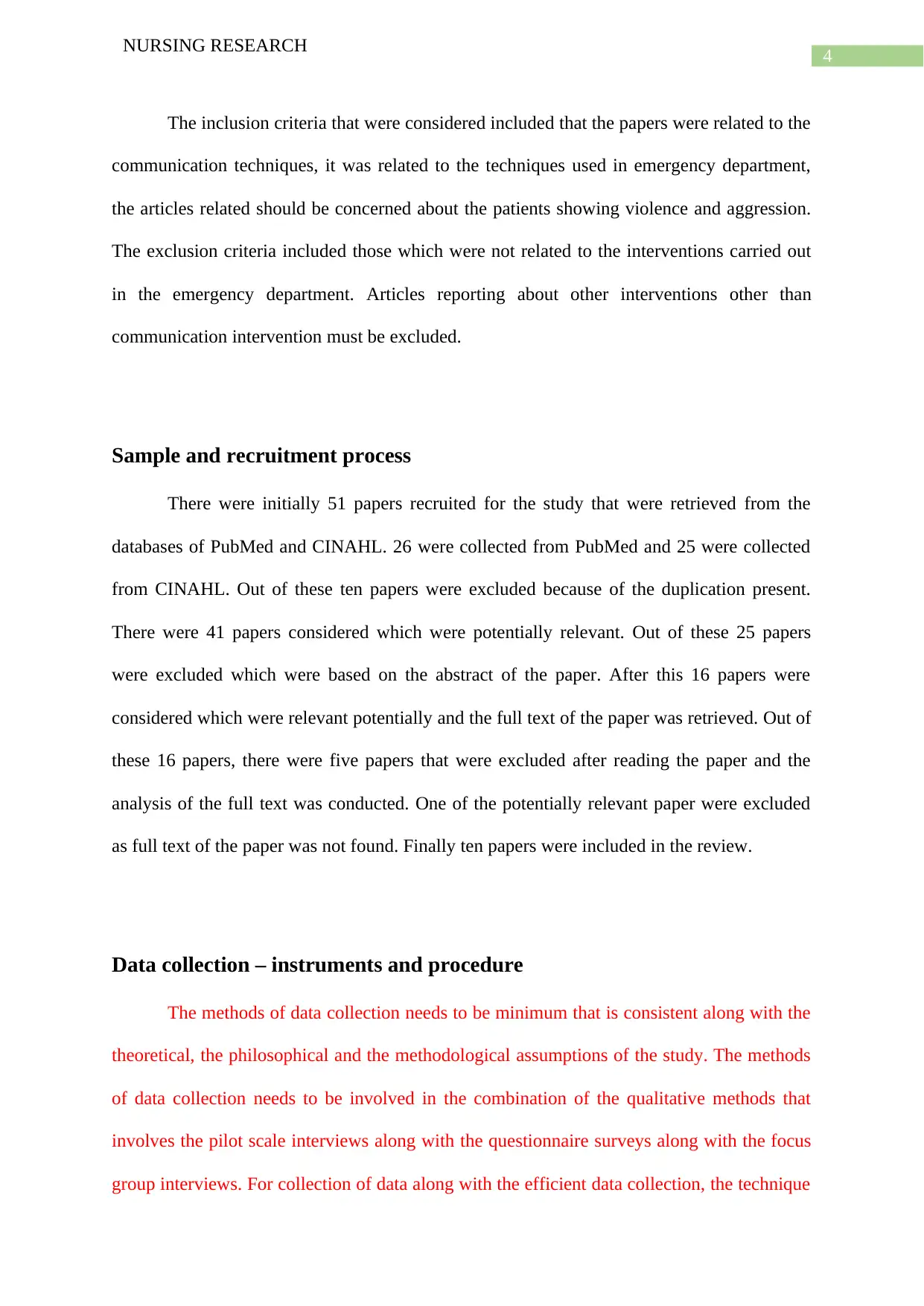
4
NURSING RESEARCH
The inclusion criteria that were considered included that the papers were related to the
communication techniques, it was related to the techniques used in emergency department,
the articles related should be concerned about the patients showing violence and aggression.
The exclusion criteria included those which were not related to the interventions carried out
in the emergency department. Articles reporting about other interventions other than
communication intervention must be excluded.
Sample and recruitment process
There were initially 51 papers recruited for the study that were retrieved from the
databases of PubMed and CINAHL. 26 were collected from PubMed and 25 were collected
from CINAHL. Out of these ten papers were excluded because of the duplication present.
There were 41 papers considered which were potentially relevant. Out of these 25 papers
were excluded which were based on the abstract of the paper. After this 16 papers were
considered which were relevant potentially and the full text of the paper was retrieved. Out of
these 16 papers, there were five papers that were excluded after reading the paper and the
analysis of the full text was conducted. One of the potentially relevant paper were excluded
as full text of the paper was not found. Finally ten papers were included in the review.
Data collection – instruments and procedure
The methods of data collection needs to be minimum that is consistent along with the
theoretical, the philosophical and the methodological assumptions of the study. The methods
of data collection needs to be involved in the combination of the qualitative methods that
involves the pilot scale interviews along with the questionnaire surveys along with the focus
group interviews. For collection of data along with the efficient data collection, the technique
NURSING RESEARCH
The inclusion criteria that were considered included that the papers were related to the
communication techniques, it was related to the techniques used in emergency department,
the articles related should be concerned about the patients showing violence and aggression.
The exclusion criteria included those which were not related to the interventions carried out
in the emergency department. Articles reporting about other interventions other than
communication intervention must be excluded.
Sample and recruitment process
There were initially 51 papers recruited for the study that were retrieved from the
databases of PubMed and CINAHL. 26 were collected from PubMed and 25 were collected
from CINAHL. Out of these ten papers were excluded because of the duplication present.
There were 41 papers considered which were potentially relevant. Out of these 25 papers
were excluded which were based on the abstract of the paper. After this 16 papers were
considered which were relevant potentially and the full text of the paper was retrieved. Out of
these 16 papers, there were five papers that were excluded after reading the paper and the
analysis of the full text was conducted. One of the potentially relevant paper were excluded
as full text of the paper was not found. Finally ten papers were included in the review.
Data collection – instruments and procedure
The methods of data collection needs to be minimum that is consistent along with the
theoretical, the philosophical and the methodological assumptions of the study. The methods
of data collection needs to be involved in the combination of the qualitative methods that
involves the pilot scale interviews along with the questionnaire surveys along with the focus
group interviews. For collection of data along with the efficient data collection, the technique
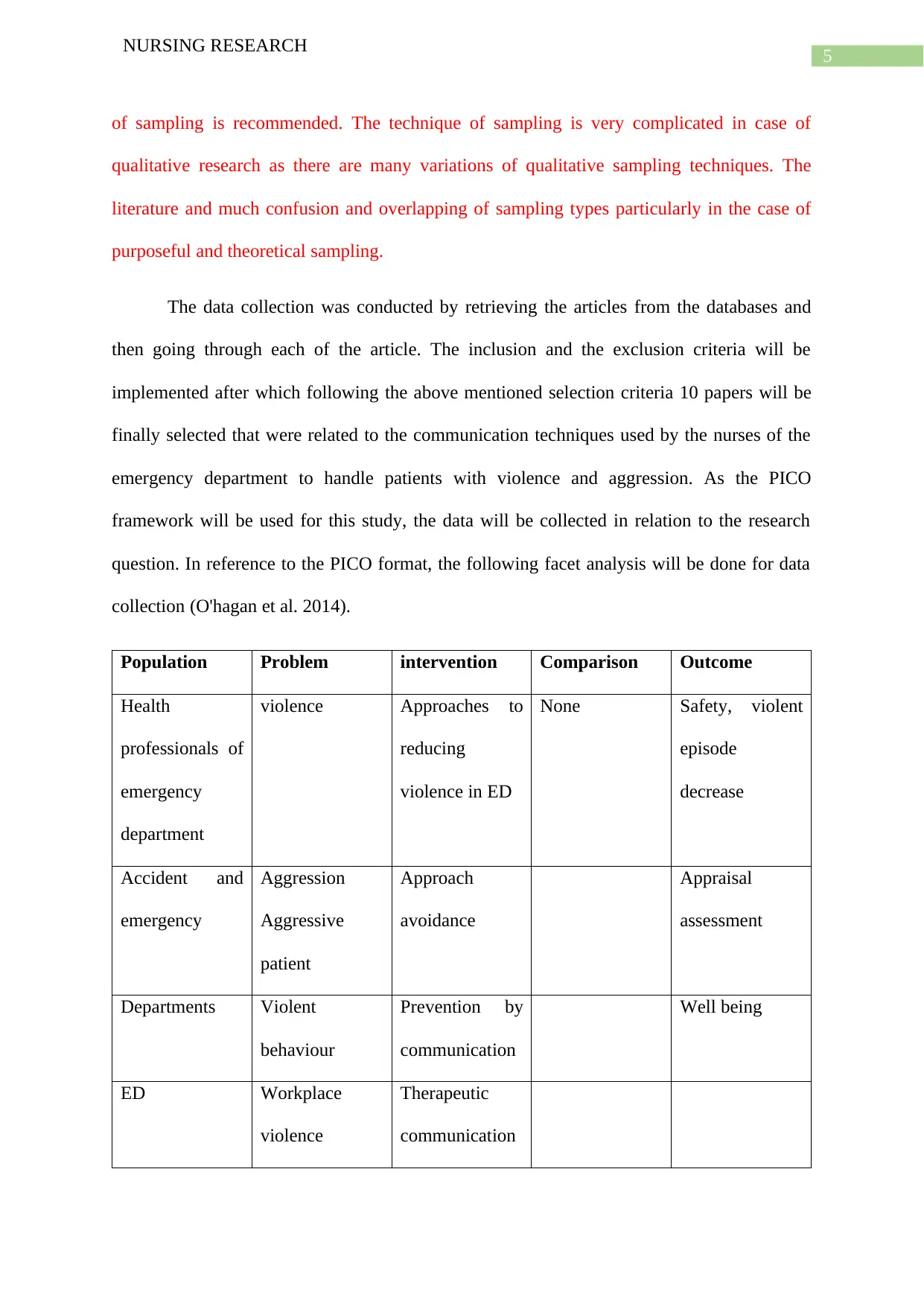
5
NURSING RESEARCH
of sampling is recommended. The technique of sampling is very complicated in case of
qualitative research as there are many variations of qualitative sampling techniques. The
literature and much confusion and overlapping of sampling types particularly in the case of
purposeful and theoretical sampling.
The data collection was conducted by retrieving the articles from the databases and
then going through each of the article. The inclusion and the exclusion criteria will be
implemented after which following the above mentioned selection criteria 10 papers will be
finally selected that were related to the communication techniques used by the nurses of the
emergency department to handle patients with violence and aggression. As the PICO
framework will be used for this study, the data will be collected in relation to the research
question. In reference to the PICO format, the following facet analysis will be done for data
collection (O'hagan et al. 2014).
Population Problem intervention Comparison Outcome
Health
professionals of
emergency
department
violence Approaches to
reducing
violence in ED
None Safety, violent
episode
decrease
Accident and
emergency
Aggression
Aggressive
patient
Approach
avoidance
Appraisal
assessment
Departments Violent
behaviour
Prevention by
communication
Well being
ED Workplace
violence
Therapeutic
communication
NURSING RESEARCH
of sampling is recommended. The technique of sampling is very complicated in case of
qualitative research as there are many variations of qualitative sampling techniques. The
literature and much confusion and overlapping of sampling types particularly in the case of
purposeful and theoretical sampling.
The data collection was conducted by retrieving the articles from the databases and
then going through each of the article. The inclusion and the exclusion criteria will be
implemented after which following the above mentioned selection criteria 10 papers will be
finally selected that were related to the communication techniques used by the nurses of the
emergency department to handle patients with violence and aggression. As the PICO
framework will be used for this study, the data will be collected in relation to the research
question. In reference to the PICO format, the following facet analysis will be done for data
collection (O'hagan et al. 2014).
Population Problem intervention Comparison Outcome
Health
professionals of
emergency
department
violence Approaches to
reducing
violence in ED
None Safety, violent
episode
decrease
Accident and
emergency
Aggression
Aggressive
patient
Approach
avoidance
Appraisal
assessment
Departments Violent
behaviour
Prevention by
communication
Well being
ED Workplace
violence
Therapeutic
communication
⊘ This is a preview!⊘
Do you want full access?
Subscribe today to unlock all pages.

Trusted by 1+ million students worldwide
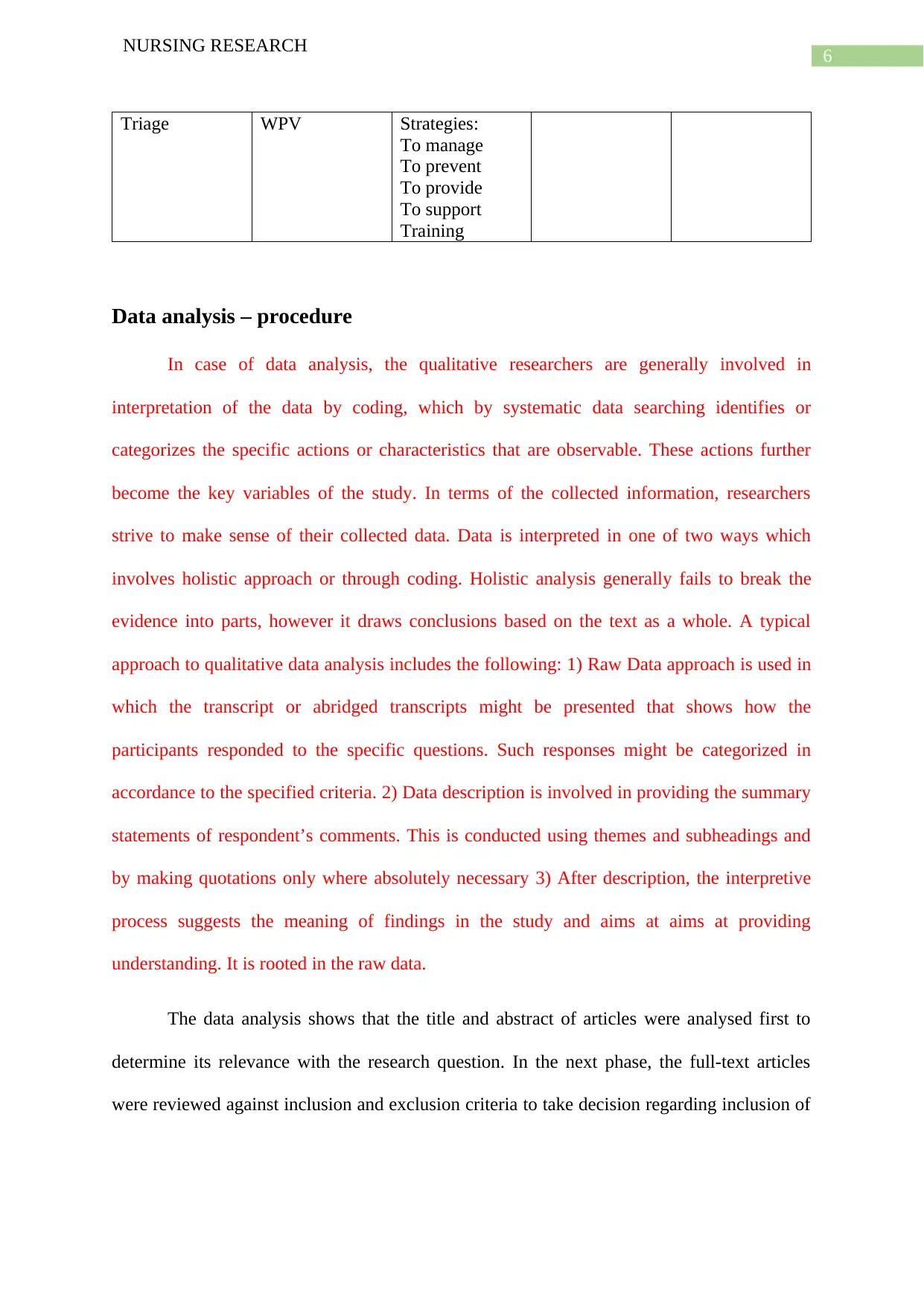
6
NURSING RESEARCH
Triage WPV Strategies:
To manage
To prevent
To provide
To support
Training
Data analysis – procedure
In case of data analysis, the qualitative researchers are generally involved in
interpretation of the data by coding, which by systematic data searching identifies or
categorizes the specific actions or characteristics that are observable. These actions further
become the key variables of the study. In terms of the collected information, researchers
strive to make sense of their collected data. Data is interpreted in one of two ways which
involves holistic approach or through coding. Holistic analysis generally fails to break the
evidence into parts, however it draws conclusions based on the text as a whole. A typical
approach to qualitative data analysis includes the following: 1) Raw Data approach is used in
which the transcript or abridged transcripts might be presented that shows how the
participants responded to the specific questions. Such responses might be categorized in
accordance to the specified criteria. 2) Data description is involved in providing the summary
statements of respondent’s comments. This is conducted using themes and subheadings and
by making quotations only where absolutely necessary 3) After description, the interpretive
process suggests the meaning of findings in the study and aims at aims at providing
understanding. It is rooted in the raw data.
The data analysis shows that the title and abstract of articles were analysed first to
determine its relevance with the research question. In the next phase, the full-text articles
were reviewed against inclusion and exclusion criteria to take decision regarding inclusion of
NURSING RESEARCH
Triage WPV Strategies:
To manage
To prevent
To provide
To support
Training
Data analysis – procedure
In case of data analysis, the qualitative researchers are generally involved in
interpretation of the data by coding, which by systematic data searching identifies or
categorizes the specific actions or characteristics that are observable. These actions further
become the key variables of the study. In terms of the collected information, researchers
strive to make sense of their collected data. Data is interpreted in one of two ways which
involves holistic approach or through coding. Holistic analysis generally fails to break the
evidence into parts, however it draws conclusions based on the text as a whole. A typical
approach to qualitative data analysis includes the following: 1) Raw Data approach is used in
which the transcript or abridged transcripts might be presented that shows how the
participants responded to the specific questions. Such responses might be categorized in
accordance to the specified criteria. 2) Data description is involved in providing the summary
statements of respondent’s comments. This is conducted using themes and subheadings and
by making quotations only where absolutely necessary 3) After description, the interpretive
process suggests the meaning of findings in the study and aims at aims at providing
understanding. It is rooted in the raw data.
The data analysis shows that the title and abstract of articles were analysed first to
determine its relevance with the research question. In the next phase, the full-text articles
were reviewed against inclusion and exclusion criteria to take decision regarding inclusion of
Paraphrase This Document
Need a fresh take? Get an instant paraphrase of this document with our AI Paraphraser
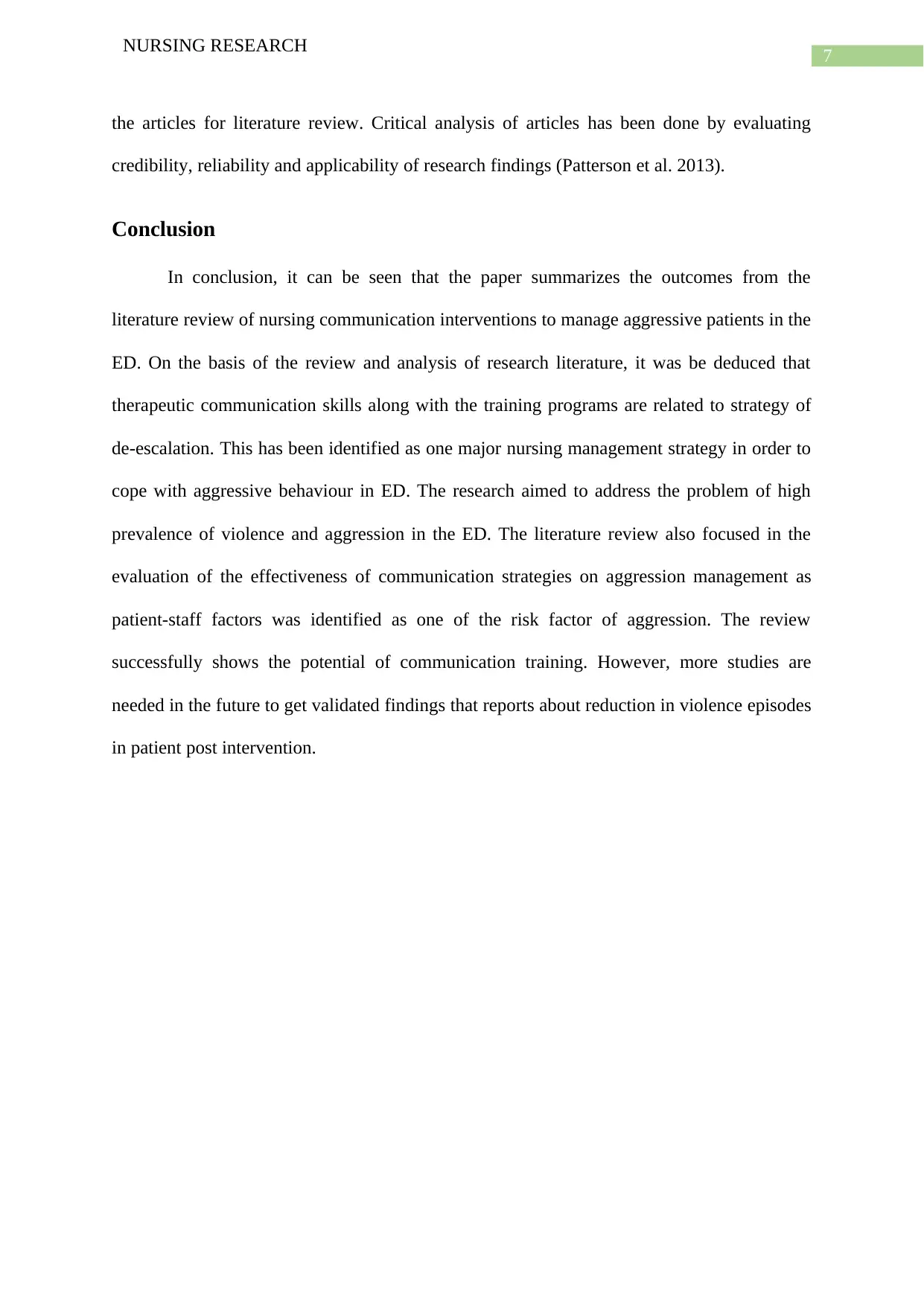
7
NURSING RESEARCH
the articles for literature review. Critical analysis of articles has been done by evaluating
credibility, reliability and applicability of research findings (Patterson et al. 2013).
Conclusion
In conclusion, it can be seen that the paper summarizes the outcomes from the
literature review of nursing communication interventions to manage aggressive patients in the
ED. On the basis of the review and analysis of research literature, it was be deduced that
therapeutic communication skills along with the training programs are related to strategy of
de-escalation. This has been identified as one major nursing management strategy in order to
cope with aggressive behaviour in ED. The research aimed to address the problem of high
prevalence of violence and aggression in the ED. The literature review also focused in the
evaluation of the effectiveness of communication strategies on aggression management as
patient-staff factors was identified as one of the risk factor of aggression. The review
successfully shows the potential of communication training. However, more studies are
needed in the future to get validated findings that reports about reduction in violence episodes
in patient post intervention.
NURSING RESEARCH
the articles for literature review. Critical analysis of articles has been done by evaluating
credibility, reliability and applicability of research findings (Patterson et al. 2013).
Conclusion
In conclusion, it can be seen that the paper summarizes the outcomes from the
literature review of nursing communication interventions to manage aggressive patients in the
ED. On the basis of the review and analysis of research literature, it was be deduced that
therapeutic communication skills along with the training programs are related to strategy of
de-escalation. This has been identified as one major nursing management strategy in order to
cope with aggressive behaviour in ED. The research aimed to address the problem of high
prevalence of violence and aggression in the ED. The literature review also focused in the
evaluation of the effectiveness of communication strategies on aggression management as
patient-staff factors was identified as one of the risk factor of aggression. The review
successfully shows the potential of communication training. However, more studies are
needed in the future to get validated findings that reports about reduction in violence episodes
in patient post intervention.
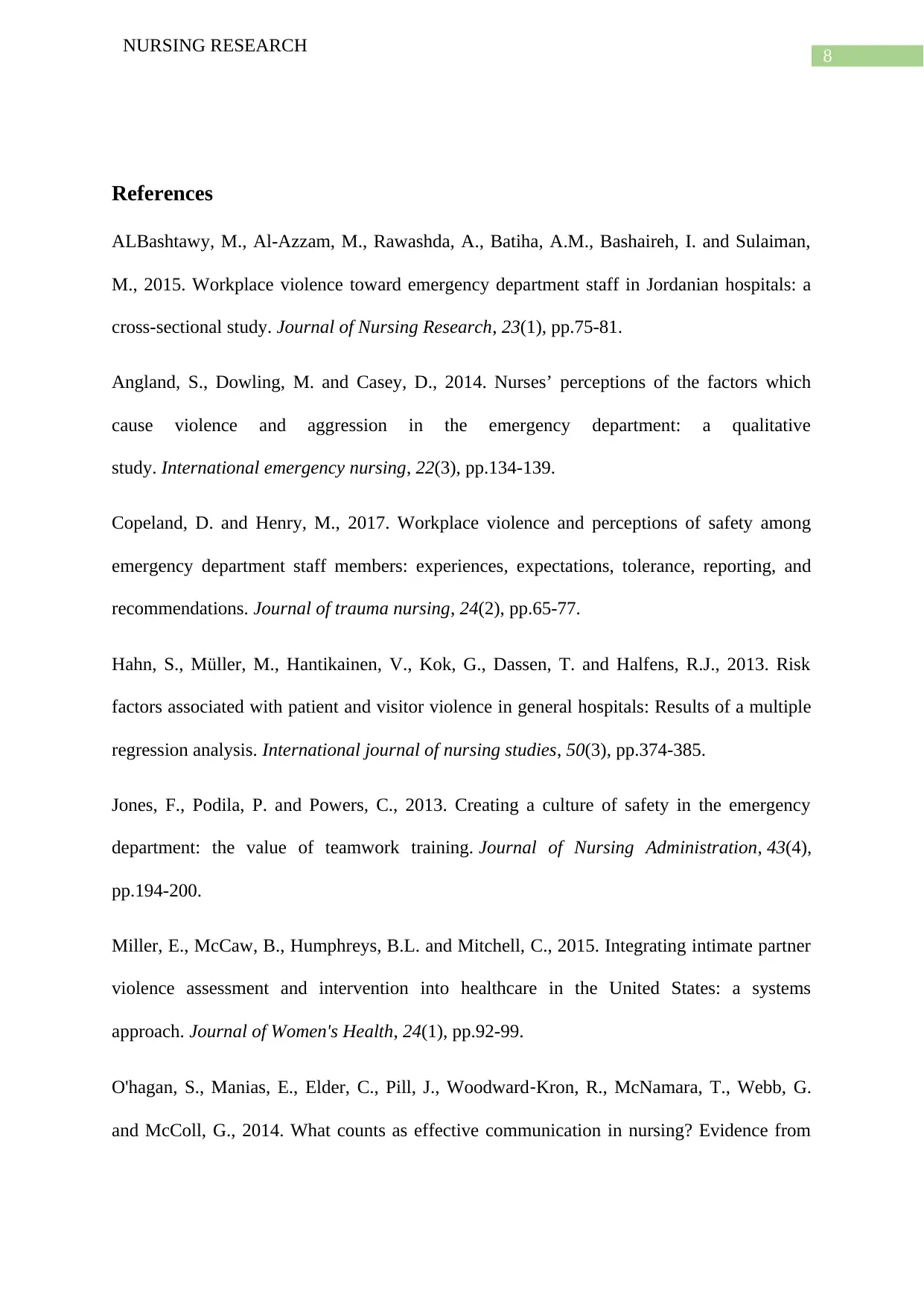
8
NURSING RESEARCH
References
ALBashtawy, M., Al-Azzam, M., Rawashda, A., Batiha, A.M., Bashaireh, I. and Sulaiman,
M., 2015. Workplace violence toward emergency department staff in Jordanian hospitals: a
cross-sectional study. Journal of Nursing Research, 23(1), pp.75-81.
Angland, S., Dowling, M. and Casey, D., 2014. Nurses’ perceptions of the factors which
cause violence and aggression in the emergency department: a qualitative
study. International emergency nursing, 22(3), pp.134-139.
Copeland, D. and Henry, M., 2017. Workplace violence and perceptions of safety among
emergency department staff members: experiences, expectations, tolerance, reporting, and
recommendations. Journal of trauma nursing, 24(2), pp.65-77.
Hahn, S., Müller, M., Hantikainen, V., Kok, G., Dassen, T. and Halfens, R.J., 2013. Risk
factors associated with patient and visitor violence in general hospitals: Results of a multiple
regression analysis. International journal of nursing studies, 50(3), pp.374-385.
Jones, F., Podila, P. and Powers, C., 2013. Creating a culture of safety in the emergency
department: the value of teamwork training. Journal of Nursing Administration, 43(4),
pp.194-200.
Miller, E., McCaw, B., Humphreys, B.L. and Mitchell, C., 2015. Integrating intimate partner
violence assessment and intervention into healthcare in the United States: a systems
approach. Journal of Women's Health, 24(1), pp.92-99.
O'hagan, S., Manias, E., Elder, C., Pill, J., Woodward‐Kron, R., McNamara, T., Webb, G.
and McColl, G., 2014. What counts as effective communication in nursing? Evidence from
NURSING RESEARCH
References
ALBashtawy, M., Al-Azzam, M., Rawashda, A., Batiha, A.M., Bashaireh, I. and Sulaiman,
M., 2015. Workplace violence toward emergency department staff in Jordanian hospitals: a
cross-sectional study. Journal of Nursing Research, 23(1), pp.75-81.
Angland, S., Dowling, M. and Casey, D., 2014. Nurses’ perceptions of the factors which
cause violence and aggression in the emergency department: a qualitative
study. International emergency nursing, 22(3), pp.134-139.
Copeland, D. and Henry, M., 2017. Workplace violence and perceptions of safety among
emergency department staff members: experiences, expectations, tolerance, reporting, and
recommendations. Journal of trauma nursing, 24(2), pp.65-77.
Hahn, S., Müller, M., Hantikainen, V., Kok, G., Dassen, T. and Halfens, R.J., 2013. Risk
factors associated with patient and visitor violence in general hospitals: Results of a multiple
regression analysis. International journal of nursing studies, 50(3), pp.374-385.
Jones, F., Podila, P. and Powers, C., 2013. Creating a culture of safety in the emergency
department: the value of teamwork training. Journal of Nursing Administration, 43(4),
pp.194-200.
Miller, E., McCaw, B., Humphreys, B.L. and Mitchell, C., 2015. Integrating intimate partner
violence assessment and intervention into healthcare in the United States: a systems
approach. Journal of Women's Health, 24(1), pp.92-99.
O'hagan, S., Manias, E., Elder, C., Pill, J., Woodward‐Kron, R., McNamara, T., Webb, G.
and McColl, G., 2014. What counts as effective communication in nursing? Evidence from
⊘ This is a preview!⊘
Do you want full access?
Subscribe today to unlock all pages.

Trusted by 1+ million students worldwide
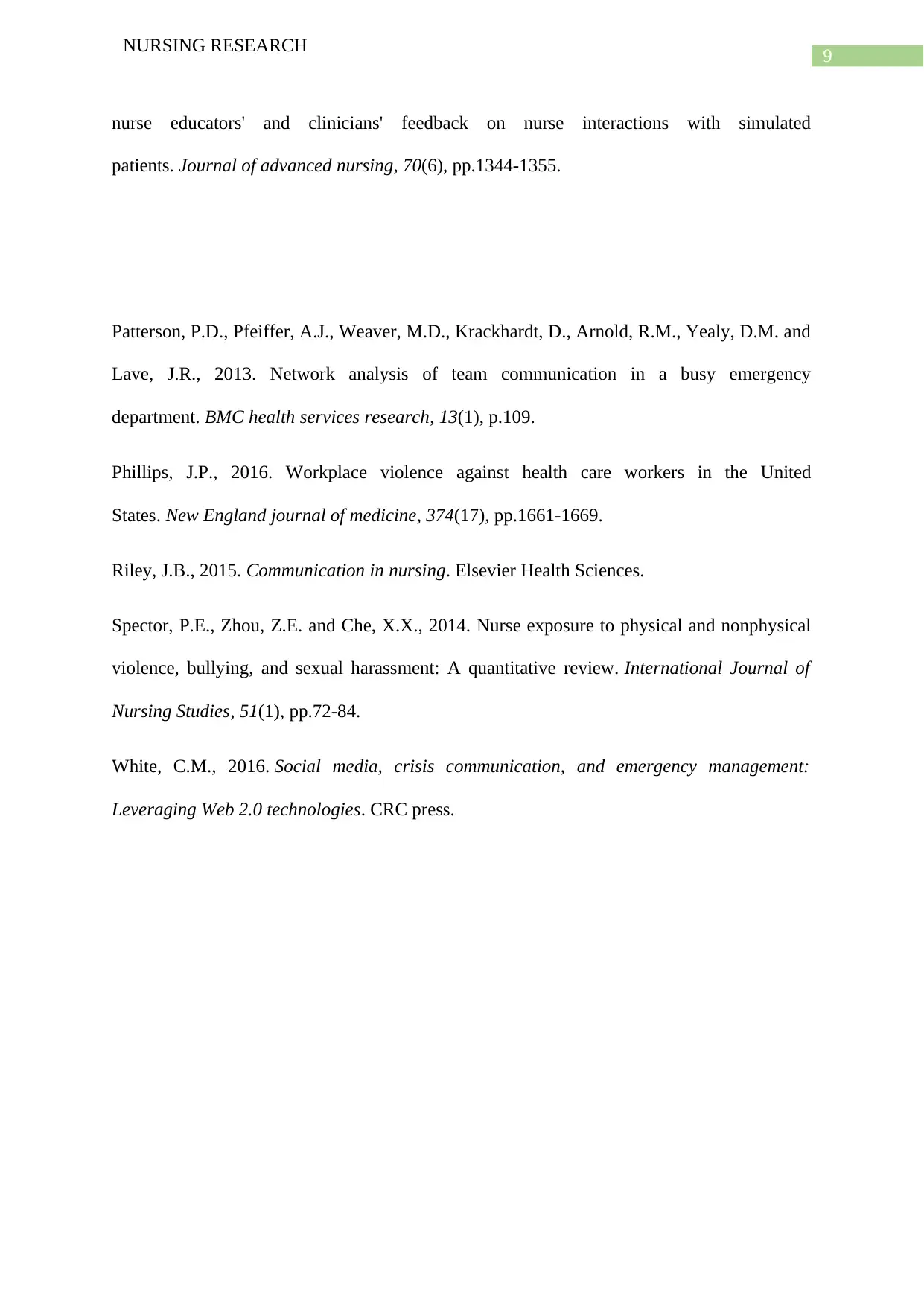
9
NURSING RESEARCH
nurse educators' and clinicians' feedback on nurse interactions with simulated
patients. Journal of advanced nursing, 70(6), pp.1344-1355.
Patterson, P.D., Pfeiffer, A.J., Weaver, M.D., Krackhardt, D., Arnold, R.M., Yealy, D.M. and
Lave, J.R., 2013. Network analysis of team communication in a busy emergency
department. BMC health services research, 13(1), p.109.
Phillips, J.P., 2016. Workplace violence against health care workers in the United
States. New England journal of medicine, 374(17), pp.1661-1669.
Riley, J.B., 2015. Communication in nursing. Elsevier Health Sciences.
Spector, P.E., Zhou, Z.E. and Che, X.X., 2014. Nurse exposure to physical and nonphysical
violence, bullying, and sexual harassment: A quantitative review. International Journal of
Nursing Studies, 51(1), pp.72-84.
White, C.M., 2016. Social media, crisis communication, and emergency management:
Leveraging Web 2.0 technologies. CRC press.
NURSING RESEARCH
nurse educators' and clinicians' feedback on nurse interactions with simulated
patients. Journal of advanced nursing, 70(6), pp.1344-1355.
Patterson, P.D., Pfeiffer, A.J., Weaver, M.D., Krackhardt, D., Arnold, R.M., Yealy, D.M. and
Lave, J.R., 2013. Network analysis of team communication in a busy emergency
department. BMC health services research, 13(1), p.109.
Phillips, J.P., 2016. Workplace violence against health care workers in the United
States. New England journal of medicine, 374(17), pp.1661-1669.
Riley, J.B., 2015. Communication in nursing. Elsevier Health Sciences.
Spector, P.E., Zhou, Z.E. and Che, X.X., 2014. Nurse exposure to physical and nonphysical
violence, bullying, and sexual harassment: A quantitative review. International Journal of
Nursing Studies, 51(1), pp.72-84.
White, C.M., 2016. Social media, crisis communication, and emergency management:
Leveraging Web 2.0 technologies. CRC press.
1 out of 10
Related Documents
Your All-in-One AI-Powered Toolkit for Academic Success.
+13062052269
info@desklib.com
Available 24*7 on WhatsApp / Email
![[object Object]](/_next/static/media/star-bottom.7253800d.svg)
Unlock your academic potential
Copyright © 2020–2025 A2Z Services. All Rights Reserved. Developed and managed by ZUCOL.





